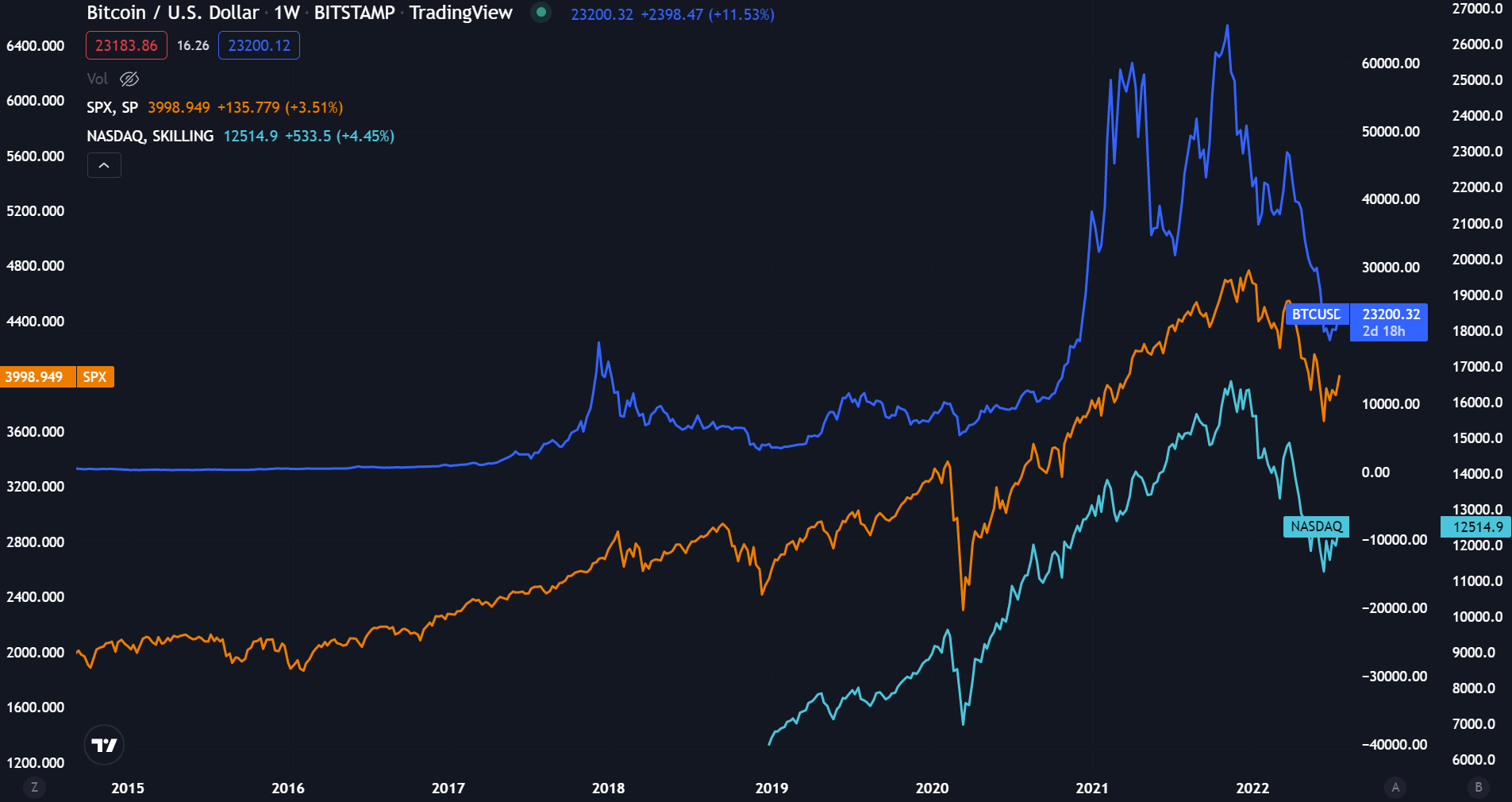What Would Happen To Bitcoin If The US Dollar Crashed?
Hedge With Crypto aims to publish information that is factual and accurate as of the date of publication. For specific information about a cryptocurrency exchange or trading platform please visit that provider’s website. This information is general in nature and is for education purposes only. Hedge With Crypto does not provide financial advice nor does it take into account your personal financial situation. We encourage you to seek financial advice from an independent financial advisor where appropriate and make your own enquiries.
Key Takeaways:
- If USD was to fall then the price of BTC would typically increase since the ‘risk-on' crypto asset is normally denominated in USD.
- A negative correlation (< -0.2) infers that the value of BTC moves against the strength of the USD. To date, negative correlations are more frequent where falls in the US Dollar mean increases in the price of BTC.
TABLE OF CONTENTS
Bitcoin and the US dollar (USD) share a lot of similarities. The two can both be used as a method of payment and can both be held as a store of value. Both assets are also intricately linked. The value of Bitcoin is most commonly denominated in US dollars and the two assets have shared both positive and negative correlations throughout Bitcoin’s existence. As a result of the close tie, it seems reasonable for Bitcoiners to ask what would happen to Bitcoin price if the US dollar were to crash. Importantly, could this mean Bitcoin will crash to zero?
What Happens to Bitcoin if the US Dollar Crashed?
The impact on Bitcoin from a US dollar crash is a difficult thing to predict. There is evidence to suggest that a crash in the US dollar could be both positive and negative for Bitcoin. Bitcoin is often priced in US dollars, so if the value of US dollars falls relative to everything else, the value of each Bitcoin would increase.
However, if Bitcoin is considered a “risk-on asset”, the panic resulting from a crash in USD would likely lead to a sudden fall in price. However, many experts predict this would be temporary, as Bitcoin may become a safe haven asset and result in the future price of Bitcoin rising substantially if the US dollar crashes.
How Would A Dollar Crash Impact Bitcoin?
In addition, a crash in the US dollar would likely be accompanied by panic. To avoid a reduction in spending power, US dollar holders may search for other assets to place funds into; a void that Bitcoin could potentially fulfil. Thanks to its capped supply, Bitcoin is viewed as a store of value by supporters and could provide an option for those looking for alternative assets.
However, this view is not shared by all. There are still individuals who believe cryptocurrencies, including Bitcoin, are far too volatile. For example, between November 2021 and June 2022, the price of Bitcoin fell 70%. During this time, Bitcoin also shared a positive correlation with stocks, which are considered a risk-on asset; an asset that should be invested in during times of economic certainty.
Related: What would happen to Bitcoin if the stock market crashed?
During times of panic, investors reduce risk on asset positions and stick to assets that are proven, such as gold. If a larger number of US dollar holders consider Bitcoin to be a risk-on asset, the price of Bitcoin could be dragged lower if the value of the US dollar falls. As historic market data shows, Bitcoin and the US dollar can share a positive correlation and move in parallel.
What Could Cause The US Dollar To Crash?
A US dollar crash refers to a moment when the value of the US dollar falls rapidly in comparison to all other fiat currencies. By fiat currencies, we mean other currencies backed by Central Banks and Governments, such as GBP, EUR, and JPY. As the reserve currency of the world, a crash in the US dollar is unlikely, but not impossible. Many currencies have crashed and failed in the past. These crashes usually stem from a lack of faith. A currency is only as strong as the faith placed in the government controlling it. For the US dollar, here are a few scenarios that could cause its value to fall rapidly:
- High inflation and high debt. High inflation coupled with high debt could be a dangerous scenario for the US dollar. High inflation is often combatted by high interest rates; a policy stance that was witnessed throughout 2022. However, higher interest rates also raise the payments required on US debt. If the US cannot sustain higher interest payments, creditors may get rid of the US dollar in favor of an alternative, which could result in a crash. Bitcoin could benefit in this scenario as it appears to be a good hedge against inflation.
- US-only recession. If the US was one of the only countries to enter into a recession, this could result in investors exiting the US dollar. With a lack of economic growth, there would be less reason to hold USD. To learn how this might affect BTC, read this article that explains what would happen to Bitcoin in a recession.
As the US dollar is the world's reserve currency and has been for generations. It is still the most used currency in the world, which means the chances of it crashing are low. Alternative currencies also employ similar monetary policies which means that swapping for an alternative may not be an answer to the scenarios above. However, the scenarios demonstrate that there are factors that could weigh heavily on USD spending power relative to other currencies in the future.
Is The US Dollar And Bitcoin Correlated?
The best way to evaluate the strength of the US dollar and, therefore, its correlation with Bitcoin is to observe the US dollar index, also known as the DXY. The DXY measures the strength of the US dollar relative to a selection of global fiat currencies including GBP, EUR, CHF, JPY, CAD, and SEK. A lower DXY reading suggests the value of the US dollar is falling. A higher DXY reading suggests the value of the US dollar is climbing.
By comparing the DXY and Bitcoin, it is clear to see that the two have shared both positive and negative correlations since Bitcoin was created in 2009. A negative correlation coefficient (<-0.2) infers that the Bitcoin price moves in opposition to the strength of the US dollar. In comparison, a positive correlation coefficient (>0.2) infers that the Bitcoin price moves in unison with the strength of the US dollar.
In Bitcoin’s short lifespan, negative correlations are more frequent. More commonly, as the US dollar falls in value, the value of Bitcoin increases. Similarly, when the US dollar rises in value, the value of Bitcoin falls.

The positive and negative correlations between these two assets are best exemplified when comparing the DXY and Bitcoin charts between 2017 and 2022. During Bitcoin’s bull cycle of 2017, as the price of Bitcoin climbed from $1,000 to $20,000, the DXY chart fell from $98 to a low of $89. Similarly, between the Covid-19 collapse in March 2020 and April 2021, while Bitcoin climbed from $4,000 to $60,000, the DXY chart fell from $102 to $89. As can be seen from the chart below, it appears to be much healthier for Bitcoin when the US dollar falls in value.
However, negative correlations have in the past made way for positive ones. Between June 2021 and November 2021, both Bitcoin and DXY were increasing in strength. It was only after November 2021 that the positive correlation ceased as Bitcoin started to fall while the DXY continued to climb higher.
The US dollar and Bitcoin do share correlations. However, that correlation can vary over time. Based on historical data, a negative correlation results in a more stable and healthier environment for Bitcoin, whereas positive correlations can sometimes lead to periods of high volatility. This has an impact on investors who wonder if Bitcoin will ever be stable enough to provide gradual appreciation.
The Future Of The Dollar
The US dollar has been the world’s reserve currency for over 60 years. As a result, approximately 60% of foreign exchange reserves are held in USD. For a long time, the US dollar and its dominance have been unmatched. But can this dominance continue into the future or are there scenarios that reduce its dominance? The global superpower landscape is continually shifting. For many years, the US has enjoyed its position as number 1. As a result, it has been able to wield the US dollar, and its associated payment networks, such as SWIFT, as a weapon, placing sanctions on countries that it deems as a threat.
However, competing superpowers, such as China and Russia are consistently looking for ways to move away from a world reliant on the US dollar. If competitors can outpace the US with regard to technology and economic policy, the US dollar may become more widely avoided.
Several experts believe the US economy is bridging into an era of digital dollars and digital assets. Advances in blockchain technology now mean that ideas such as Central Bank Digital Currencies (CBDCs) – a digital version of a national currency – are becoming a reality. CBDCs would eliminate the intermediary role of traditional payment systems and allow for greater efficiency, albeit at the risk of privacy.
However, the US is falling behind in this digital race. With China’s high focus on technology, the Central Bank of China has already implemented a digital version of the Yuan, which has left countries like the US to play catch up. The future of the US dollar is potentially not as clear as it once was. Due to the world’s comfort with the USD, it will likely remain the world’s reserve currency for years to come. However, competition and innovation from competitors may adjust its dominance, including the possibility of Bitcoin gaining worldwide reserve currency status.
Frequently Asked Questions
Can the US dollar crash?
Yes, the value of the US dollar can fall dramatically, however, the likelihood of that happening remains low. Analysts have predicted a crash in the US dollar ever since the currency took a prominent place within the global economic landscape. In 2022, the US dollar remains the strongest fiat currency in the world and is consistently used as a store of value during times of economic hardship.
Is Bitcoin immune to inflation?
80% of all US dollars in circulation were printed between March 2020 and January 2022. New liquidity was generated to combat the economic slowdown that ensued as a result of the Covid-19 pandemic. However, printing new money resulted in a devaluation of all US dollars in circulation. In other words, new liquidity resulted in an inflation of the price of goods and services globally.
What should you own if the dollar collapses?
It is difficult to accurately predict what assets an individual should own if the US dollar were to crash. Different asset classes might react unexpectedly in such a scenario. However, it is good practice to own a diversified portfolio that includes a range of different asset classes including stocks, commodities, bonds, real estate, and crypto.



